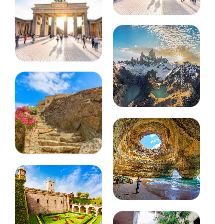Visit the Arc de Triomphe in Paris
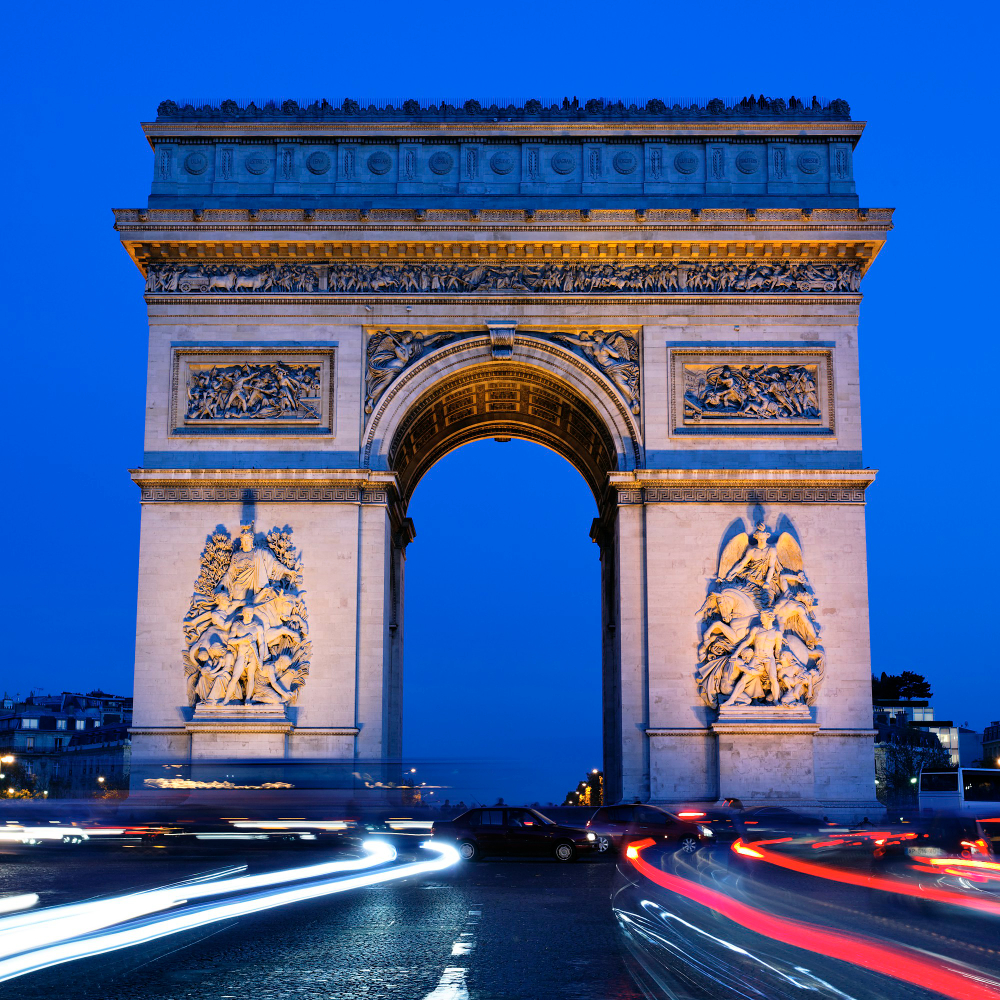
The Arc de Triomphe in Paris is one of the French capital’s most emblematic monuments. Located at the top of the Champs-Élysées, this architectural masterpiece commissioned by Napoleon I offers an exceptional panoramic view of the whole of Paris. With its history, grandiose architecture and panoramic terrace 50 metres above ground, find out everything you need to know about visiting Paris and its most prestigious monument.
200 audioguided tours for cities all around the world
DownloadWhat is the Arc de Triomphe in Paris?
The Arc de Triomphe de l’Étoile is a French war memorial erected in honour of the soldiers of the Grande Armée. Standing 50 metres high and 45 metres wide, it occupies the centre of the Place Charles-de-Gaulle, formerly the Place de l’Étoile, in the 8th arrondissement of Paris. This emblematic monument marks the point where twelve avenues converge, including the famous Avenue des Champs-Élysées.
From its panoramic terrace, accessible after 284 steps, the Arc de Triomphe offers one of the finest views of Paris. The monument is also home to the tomb of the Unknown Soldier and its eternal flame, which has been rekindled every evening at 6.30pm since 1923. This daily ceremony perpetuates the memory of all those who gave their lives for France.
Download the audio tour to discover Paris on foot and on your own
Let us guide you as you explore the capital with theNavaway itinerary for visiting Paris. This 8.9 km audioguided tour takes you from the Champs-Élysées to the Arc de Triomphe, passing through the city’s must-see sites. Discover 18 points of interest with historical commentary and captivating anecdotes for an enriching 3h40 tour.
See also the Paris guide :
- The best activities in and around Paris
- Visit Paris in 3 days
- Free activities and visits in Paris
- The most beautiful walks in Paris
- Historic monuments in Paris
1. The fascinating history of the Arc de Triomphe
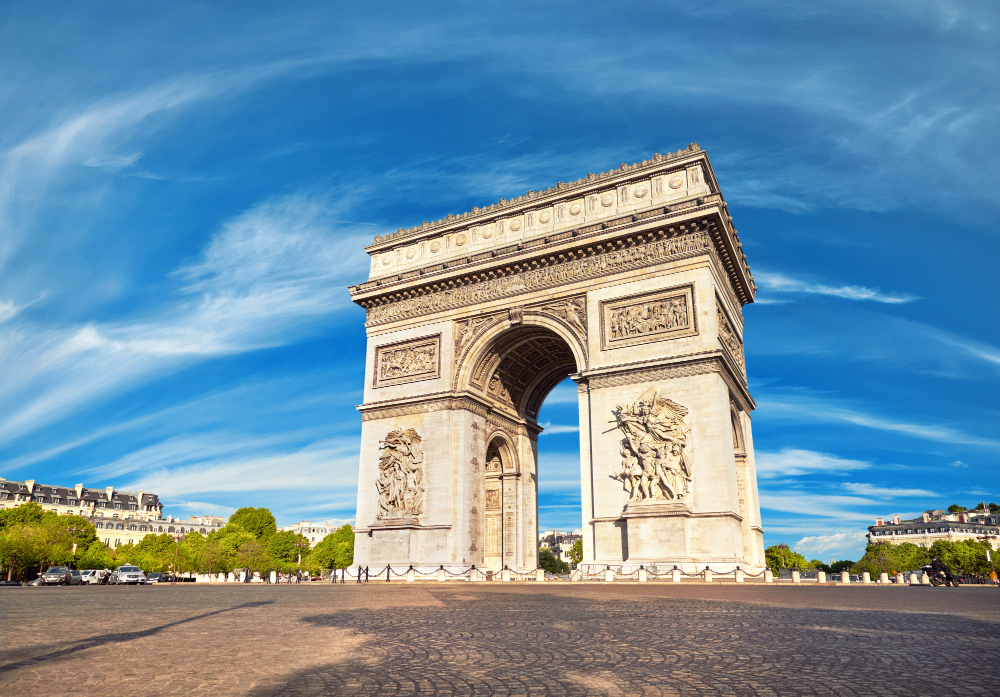
The story of the Arc de Triomphe in Paris began in 1806, the day after the Battle of Austerlitz. Napoleon I, exhilarated by this dazzling victory, made a memorable promise to his soldiers: “You will only return to your homes under triumphal arches! This declaration marked the birth of a grandiose architectural project that would span the political regimes of the world.
Napoleon’s imperial commission
On 18 February 1806, the Emperor officially ordered the construction of a triumphal arch on the Place de l’Étoile. Inspired by the ancient Roman arches, in particular the Arch of Titus, Napoleon wanted to create a monument that would surpass all its predecessors in size and magnificence. Architects Jean-François-Thérèse Chalgrin and Jean-Arnaud Raymond were appointed to carry out this colossal project.
The first stone was symbolically laid on 15 August 1806, the Emperor’s birthday. The foundations, 8 metres deep, required major earthworks on the sloping ground. The Pharaonic project then began, with an initial budget of 20 million gold francs.
An eventful construction
The construction of the Arc de Triomphe was not without its ups and downs. In 1814, the fall of Napoleon led to the suspension of work. At the time, the monument was barely sketched out, only a few metres high. Under the Restoration, Louis XVIII was reluctant to continue with this Napoleonic symbol.
It was finally under the reign of Louis-Philippe that work began in earnest in 1833. The French king, keen to achieve national reconciliation, decided to complete this monument to the glory of the French military. The sculptors François Rude, Antoine Étex, Jean-Pierre Cortot and James Pradier created the four monumental groups that adorn the pillars.
The inauguration and posterity
The Arc de Triomphe was finally inaugurated on 29 July 1836, 30 years after work had begun. Ironically, Napoleon I never saw his arch completed, but he did pass through it: in December 1840, the funeral cortege carrying his ashes from St Helena solemnly crossed the Arc de Triomphe on its way to the Invalides.
Since then, the Arc de Triomphe has become the setting for all the great moments in French history. It has housed the tomb of the Unknown Soldier since 1921 and is the setting for military parades on 14 July. This monument now symbolises national pride and the collective memory of the French people.
2. The grandiose architecture of the Arc de Triomphe
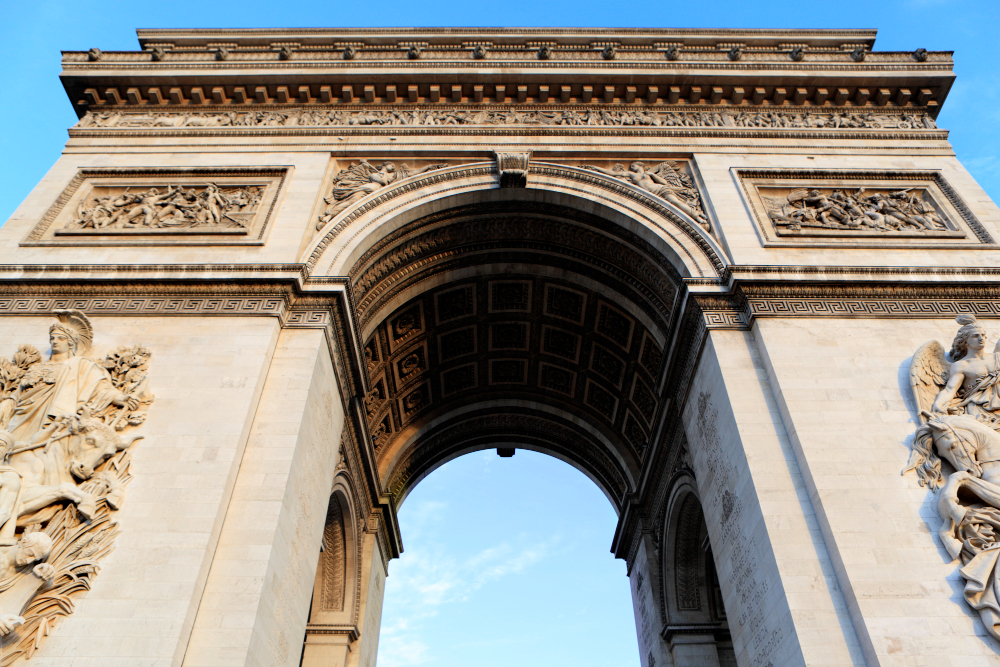
The Arc de Triomphe in Paris impresses with its exceptional dimensions and neoclassical architectural style. At 50 metres high, 45 metres wide and 22 metres deep, it remains one of the largest triumphal arches in the world. This architectural feat perfectly combines ancient inspiration and modern construction techniques.
Monumental proportions
The Arc de Triomphe consists of three arches: a large central arch 14.62 metres wide and 29.19 metres high, flanked by two smaller arches. This three-bay architecture is inspired by the Roman arches, but far exceeds them in size. The thickness of the walls, which in places are several metres thick, testifies to the solidity intended by the designers.
The materials chosen reflect the desire for grandeur: Château-Landon cut stone for the main structure, enhanced by high-relief sculptures. The whole structure rests on 8-metre-deep foundations, necessary to support the colossal weight of several thousand tonnes.
Sculpted masterpieces
The four pillars of the Arc de Triomphe bear monumental sculpted groups that are among the masterpieces of French sculpture. The most famous, “The Departure of the Volunteers of 1792” (nicknamed “La Marseillaise”) by François Rude, adorns the right pillar on the Champs-Élysées side. This dynamic work symbolises the patriotic spirit of the revolution.
Opposite, “Le Triomphe de 1810” by Antoine Étex celebrates Napoleon’s victories. On the pillar on the Avenue Kléber side, “La Résistance de 1814” by the same sculptor evokes the French resistance to the invasion. Finally, “La Paix de 1815” completes the ensemble, representing the return to peace after the Napoleonic wars.
Historical inscriptions
The interior of the Arc de Triomphe houses a veritable stone library. The walls are engraved with 660 names: 558 generals and admirals from the Revolution and the Empire, as well as 128 victorious battles. These inscriptions, created by the architect Jean-Nicolas Huyot, transform the monument into a national memorial.
Some names are underlined: they refer to generals who died in battle. This distinction pays tribute to the sacrifices made for the country. Taken together, they form a formidable record of the French military epic between 1792 and 1815.
3. What to see when you visit the Arc de Triomphe
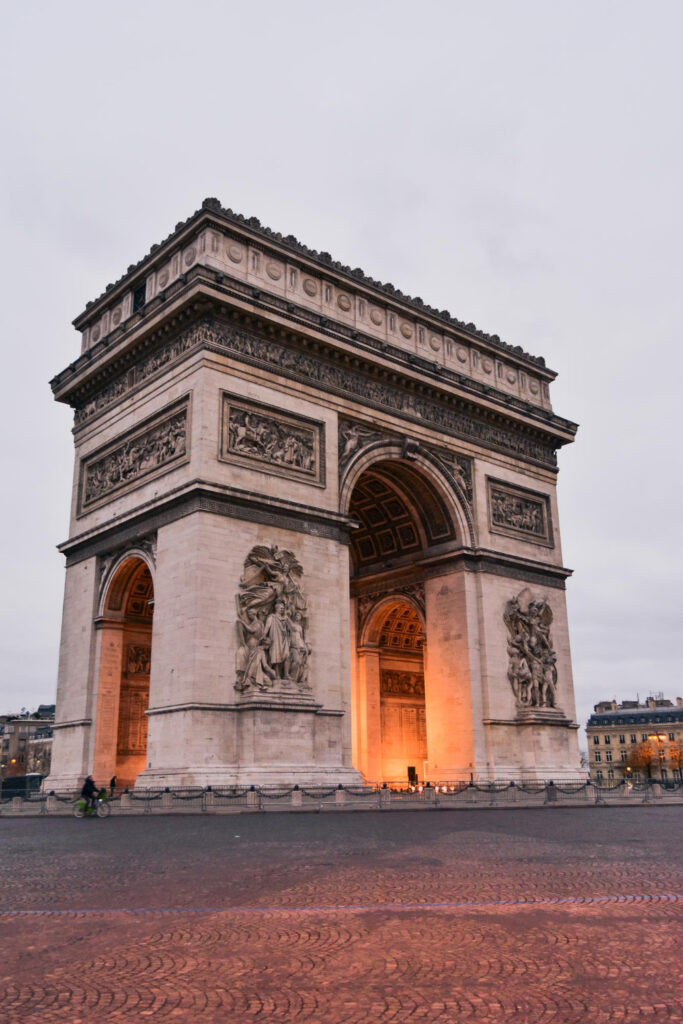
A visit to the Arc de Triomphe is full of discoveries, from the tomb of the Unknown Soldier at street level to the panoramic terrace at the top. Each level of the monument tells a part of French history and offers unique perspectives on Parisian architecture.
The tomb of the Unknown Soldier and the eternal flame
At the foot of the Arc de Triomphe, under the central vault, the tomb of the Unknown Soldier has lain since 11 November 1921. This symbolic tomb honours all the French servicemen who died without being identified during the First World War. A simple bronze plaque bears the inscription: “Here lies a French soldier who died for his country 1914-1918”.
The eternal flame has been burning continuously since 11 November 1923. Every evening at 6.30pm, veterans and representatives of patriotic associations rekindle this flame of remembrance. This daily ceremony, which is open to the public, is one of the most moving moments in the life of the monument.
The Arc de Triomphe Museum
Halfway up the monument, the museum traces the history of the Arc de Triomphe from its conception to the present day. Models, period documents and artefacts explain the different phases of construction. A detailed scale model explains the complex architecture of the monument.
The museum also presents the evolution of the symbol of the Arc de Triomphe in the French imagination. From Napoleonic monument to Republican symbol, the Arc has survived the various regimes while retaining its patriotic dimension. Interactive terminals allow visitors to explore the site in greater depth, depending on their interests.
The ascent to the terrace
The panoramic terrace is accessed via a spiral staircase with 284 steps. This climb, which requires a moderate physical effort, allows you to observe the internal architecture of the Arc de Triomphe. The thick walls reveal the complexity of the construction, with its systems of vaults and buttresses.
A lift is available for people with reduced mobility and those who need it, without prior reservation. The ascent takes around 15 to 20 minutes for visitors in good physical condition, with the option of taking breaks on the intermediate landings.
The 360° panoramic terrace
Once at the top, visitors discover one of the most beautiful panoramas of Paris. At a height of 50 metres, the terrace offers a 360-degree view of the capital. To the west, you can see La Défense and its skyscrapers. To the east, the historic axis unfolds: Champs-Élysées, Place de la Concorde, Tuileries Gardens and the Louvre all line up perfectly.
To the south, the Eiffel Tower (Champ de Mars, 5 Avenue Anatole France, 75007 Paris, rated 4.6/5 on Google with over 300,000 reviews) dominates the skyline, while to the north, the Sacré-Coeur Basilica crowns the Montmartre hilltop. This bird’s-eye view helps you to understand Parisian urban planning and how the Arc de Triomphe fits into the capital’s geography. The twelve avenues that converge on Place Charles-de-Gaulle form the star that gives the square its name.
4. Practical information for visiting the Arc de Triomphe
To prepare for your visit to the Arc de Triomphe, you need to know the opening times, prices and conditions of access. This practical information will help you make the most of your visit to this iconic monument and avoid queuing at peak times.
Opening and closing times
The Arc de Triomphe is open all year round, with opening times varying according to the season. From 1 April to 30 September, the monument welcomes visitors from Wednesday to Monday from 10am to 11pm, and on Tuesdays from 11am to 11pm. From 1 October to 31 March, opening times are slightly reduced: Wednesday to Monday from 10am to 10.30pm, and Tuesdays from 11am to 10.30pm.
The last access to the monument is authorised 45 minutes before closing time. Please note that the Arc de Triomphe closes on certain public holidays: 1 January, 1 May, 8 May (morning), 14 July (morning), 11 November (morning) and 25 December. The Tomb of the Unknown Soldier remains freely accessible even when the monument is closed to visitors.
Prices and ticketing 2025
In 2025, the individual price for visiting the Arc de Triomphe is €16 during normal periods. From 2 June to 30 September 2025, the rate will rise to €22, except on Wednesdays when it will remain at €16. This price adjustment is designed to regulate visitor numbers during the peak tourist season.
Several categories of visitor are entitled to free admission: under-18s, 18-25 year-olds from the European Union, disabled people and their carers, and jobseekers on presentation of recent proof of employment. Admission is free on the first Sunday of January, February, March, November and December.
Access and transport
The Arc de Triomphe is located Place Charles de Gaulle in the 8th arrondissement of Paris (Place Charles de Gaulle 75008 Paris, rated 4.5/5 on Google for over 180,000 reviews). The monument can only be accessed via the underground passageway known as the “Passage du Souvenir”, which can be reached from the top of the Champs-Élysées or the Avenue de la Grande-Armée.
By public transport, Charles-de-Gaulle-Étoile station is served by metro lines 1, 2 and 6 and RER line A. Several bus lines also stop nearby: 22, 30, 31, 52, 73, 92 and Balabus. For those coming by car, we recommend using the nearby Indigo car parks, as surface parking is very limited.
Visiting conditions and recommendations
Visiting the Arc de Triomphe requires a few precautions. Luggage larger than 40x40x20cm is not permitted and there are no left-luggage lockers on site. Pushchairs are not allowed inside, but can be left with the access control officers.
For security reasons (Vigipirate plan), certain objects are prohibited: flags, banners, selfie poles, tripods, sharp objects and glass bottles. We recommend that you wear comfortable clothing and good shoes to climb the 284 steps. The average visit lasts between 45 minutes and 1 hour.
5. How to get to the Arc de Triomphe
Located in the heart of Paris, the Arc de Triomphe is exceptionally accessible by all means of transport. Its central position on Place Charles-de-Gaulle makes it a natural focal point for exploring the French capital.
By metro and RER
Charles-de-Gaulle-Étoile station is the most convenient way to get to the Arc de Triomphe. This major station on the Ile-de-France network is served by three metro lines (1, 2 and 6) as well as the RER A. Line 1, which is automated, links the Arc de Triomphe directly to the Louvre, the Champs-Élysées and the Château de Vincennes.
From Gare du Nord, take RER line B to Châtelet-Les Halles, then line 1 towards Château de Vincennes to Charles-de-Gaulle-Étoile. From Gare de Lyon, line 1 takes you directly to your destination in around 15 minutes. These direct links make it much easier to get to the monument from the main Paris stations.
By bus
Several bus routes serve the Place Charles-de-Gaulle: routes 22, 30, 31, 52, 73, 92 and the tourist Balabus. This last line is particularly interesting for visitors as it links the main Parisian monuments. The advantage of the bus is that you can explore the city above ground and reach the Arc de Triomphe at the same time.
Bus stops are located on the various avenues that radiate out from the square. It is important to note that access to the monument itself is via the subway, as crossing the square on the surface is extremely dangerous due to the heavy traffic.
On foot from nearby monuments
The Arc de Triomphe is the perfect way to discover Paris on foot. From the Eiffel Tower, allow around 25 minutes to walk along Avenue Kléber. This route offers great views of the Haussmann architecture.
From the Place de la Concorde, the walk up the Champs-Élysées to the Arc de Triomphe is one of the most emblematic promenades in Paris. This 2-kilometre avenue can be covered in 20-25 minutes on foot, allowing you to admire the luxury boutiques and the bustle of this legendary thoroughfare. Don’t hesitate to let yourself be guided by theNavaway itinerary to enrich your journey with historical anecdotes.
By car and parking
Although Paris is not a particularly car-friendly city, the Arc de Triomphe is still accessible by car. From outside Paris, take the Porte Maillot exit and follow the avenue de la Grande-Armée, or the Porte Dauphine exit and follow the avenue Foch.
However, parking is a problem in the immediate vicinity of the monument. We recommend that you use the Indigo underground car parks, particularly the one on Place de l’Étoile. Vélib’ stations are also available on rue Arsène Houssaye, avenue Hoche, rue Beaujon, rue Balzac and rue Traktir for those wishing to complete their journey by bike.
6. Events and ceremonies at the Arc de Triomphe
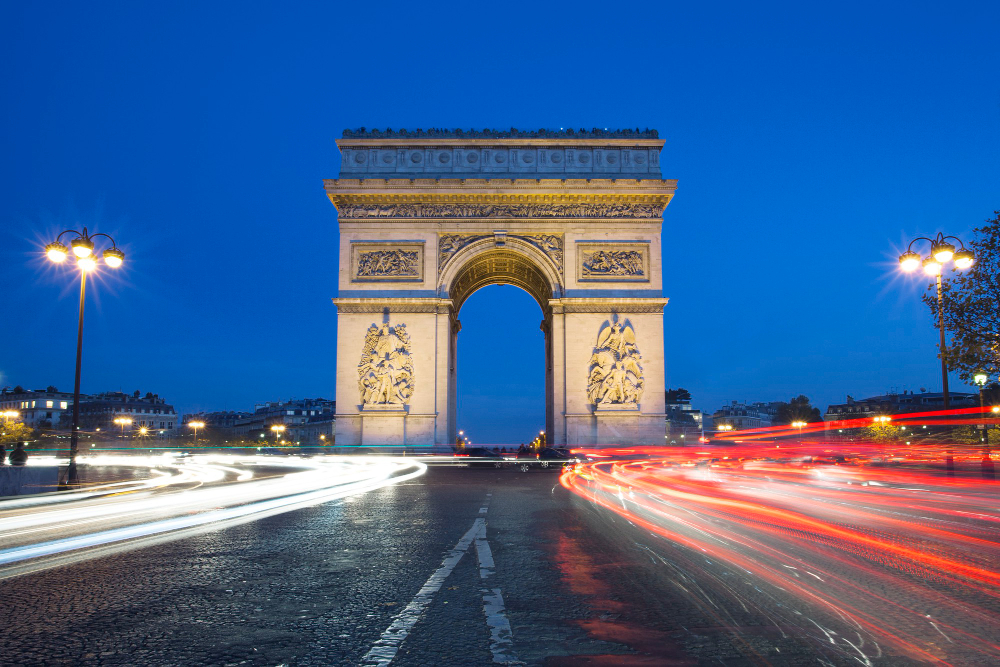
The Arc de Triomphe is not just a historic monument, it is also a living place where official ceremonies and significant events take place on a regular basis. These events perpetuate the symbolic dimension of the monument and reinforce its role in France’s collective memory.
The daily rekindling ceremony
Every evening at 6.30pm sharp, the flame of the Unknown Soldier is rekindled in a moving ceremony. This tradition, which has been maintained since 1923, brings together veterans, representatives of patriotic associations and official figures. The ceremony, which lasts around 15 minutes, is open to the public.
The ceremony follows a precise protocol: laying of wreaths, rekindling of the flame, meditation and the Last Post. This solemn moment is a daily reminder of the sacrifice of the soldiers who died for France. It is advisable to arrive a few minutes before 6.30pm to observe this century-old tradition.
The 14 July parade
The 14 July military parade on the Champs-Élysées is one of the most spectacular events of the year at the Arc de Triomphe. This parade, which traditionally begins with a flypast by the Patrouille de France, sees all the French armed forces march from the Arc de Triomphe towards the Place de la Concorde.
The monument served as a symbolic starting point for this bank holidays celebration. Officials take their seats on a specially installed rostrum, while thousands of spectators crowd the Champs-Élysées. Please note: the Arc de Triomphe is closed to the public on the morning of 14 July because of this event.
Historical commemorations
The Arc de Triomphe regularly hosts commemorative ceremonies linked to major events in French history. On 11 November, the anniversary of the 1918 Armistice, a particularly solemn ceremony is held in the presence of the President of the Republic and the highest State authorities.
Other significant dates are also commemorated: 8 May (the end of the Second World War in Europe), national days dedicated to the victims of contemporary conflicts, and tributes to the victims of terrorism. These ceremonies reinforce the Arc de Triomphe’s role as a symbol of national remembrance.
7. The Arc de Triomphe in culture and art
Beyond its historical and architectural dimensions, the Arc de Triomphe occupies a unique place in French and international culture. This emblematic monument has inspired numerous artists and continues to influence contemporary art, as well as serving as the backdrop for countless cinematographic and literary works.
A universal artistic symbol
The Arc de Triomphe has inspired many artists since its construction. Romantic painters such as Eugène Delacroix immortalised its silhouette, while the Impressionists captured the play of light on its sculptures. More recently, the ephemeral installation “L’Arc de Triomphe, Wrapped” by Christo and Jeanne-Claude in 2021 has transformed the monument into a work of contemporary art, attracting millions of visitors.
This major artistic intervention demonstrated the monument’s ability to reinvent itself while retaining its symbolic dimension. Wrapped in 25,000 square metres of silver fabric, the Arc de Triomphe revealed new perspectives and sparked a fascinating debate on art in the public space.
A legendary film set
The Arc de Triomphe appears in countless films, documentaries and TV series. From “Amélie Poulain” to “Mission Impossible”, not forgetting war films and romantic comedies, the monument is used as an emblematic backdrop to represent Paris in world cinema.
The Arc de Triomphe’s presence on screen is more than just decorative: it conveys values of grandeur, history and romance that enrich the narrative. Filmmakers exploit its exceptional vistas and symbolic power to anchor their stories in the Parisian imagination.
Global architectural influence
The Arc de Triomphe in Paris has inspired numerous replicas and adaptations around the world. The Arc de Triomphe du Carrousel in the Louvre, which is older and smaller, already bears witness to this influence. But it is above all on the international stage that Parisian inspiration is evident: the Arco della Pace in Milan, the Pyongyang Arc de Triomphe in North Korea, and the Patuxai in Vientiane, Laos.
These monuments bear witness to the universal influence of the Parisian model and its ability to embody the national aspirations of different peoples. Each local adaptation reinterprets the architectural codes while retaining the monumental spirit of the original.
8. Tips for making the most of your visit
To make the most of your visit to the Arc de Triomphe, a few practical tips are in order. These recommendations will help you avoid the crowds, optimise your time and enjoy a rewarding experience of this exceptional monument.
The best times to visit
To avoid overcrowding, choose early morning (10am-11am) or late afternoon (after 5pm) slots. Tuesdays and Wednesdays are generally less busy than weekends. In winter, visitor numbers drop significantly, offering a more peaceful visit despite the sometimes difficult weather conditions.
The end of the day offers the added advantage of watching the sun set from the terrace, creating a magical atmosphere over Paris. If you are visiting in summer, avoid the hottest hours (12pm-4pm), as climbing the 284 steps can be a real pain in the heat.
Combine with other visits
The Arc de Triomphe is a perfect addition to a tour of Paris’s must-see historic monuments. A typical day could start at Place de la Concorde, walk up the Champs-Élysées to the Arc de Triomphe, then descend to the Petit Palais (Avenue Winston Churchill, 75008 Paris, rated 4.5/5 on Google for over 25,000 reviews) and the Grand Palais.
This 3-4 hour walk provides a comprehensive overview of Paris’s historic axis. Don’t hesitate to use theNavaway application, which offers an audio-guided tour linking these different monuments with enriching historical commentaries.
Physical and material preparation
Climbing the 284 steps requires a reasonable level of fitness. Wear comfortable shoes and avoid high heels. A bottle of water can be useful, especially in summer. Don’t forget your camera or smartphone to capture the exceptional panoramic view from the terrace.
If you have difficulty climbing the stairs, ask about the availability of the lift reserved for people with reduced mobility. Finally, check the weather forecast before your visit, as the uncovered terrace can be unpleasant on windy or rainy days.
In conclusion, the Arc de Triomphe in Paris is much more than just a monument: it’s a concentration of French history, an architectural masterpiece and an inescapable national symbol. From its panoramic terrace, you can discover Paris from an exceptional angle while soaking up the unique atmosphere of this emotionally-charged site. Whether you’re a history buff, architecture enthusiast or simply curious, a visit to the Arc de Triomphe will be a highlight of your discovery of the capital. Don’t hesitate to complete this experience by following theNavaway itinerary to explore Paris and its hidden treasures.
Frequently asked questions
How long does it take to visit the Arc de Triomphe?
A full visit to the Arc de Triomphe takes around 45 minutes to 1 hour. Allow 15-20 minutes to climb the 284 steps, 10-15 minutes for the museum and 15-20 minutes to enjoy the panoramic terrace. If you want to take your time taking photos and admiring the view, allow 1? hours.
Is the Arc de Triomphe accessible to people with reduced mobility?
Yes, a lift is available for people with reduced mobility and their companions, without the need for prior reservation. Access is via the same underground passageway as for all visitors. The lift is free of charge for disabled people and an accompanying adult.
Is the Arc de Triomphe free to visit?
Admission is free for several categories: under-18s, 18-25s from EU countries, disabled people and jobseekers. Admission is also free for everyone on the first Sunday in January, February, March, November and December. The Tomb of the Unknown Soldier is always accessible free of charge.
Are there any restrictions on climbing onto the terrace?
Access to the terrace is via a 284-step staircase (or lift for PRMs). Luggage larger than 40x40x20cm, pushchairs, selfie poles, tripods and sharp objects are not permitted. In the event of adverse weather conditions, access to the terrace may be temporarily closed for safety reasons.
Can I attend the rekindling ceremony?
Yes, the rekindling ceremony takes place every evening at 6.30pm and is free to attend. This century-old tradition lasts about 15 minutes. It is advisable to arrive a few minutes early to get a good seat. The ceremony takes place even in bad weather and is a particularly moving moment.
200 audioguided tours for cities all around the world
Download